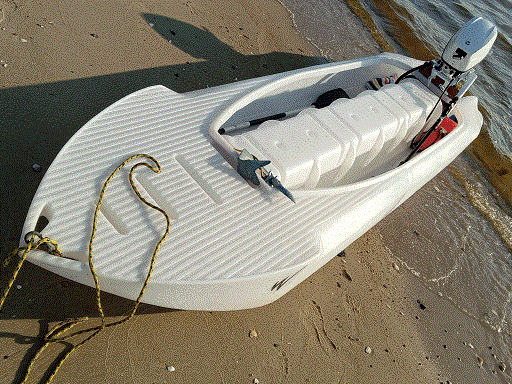Fishing the Texas flats is demanding!
First thing to consider are the size and weight of the boat itself.
A bigger and wider boat would be more stable and more comfortable, in principle, and a more convenient platform to fish from during long trips. However, a bigger boat must be transported on a trailer, and launched from a boat ramp as well as taken out there, and this greatly complicates things for you, on top of issues such as maintenance, repairs, etc, and most importantly, how much the boat drafts. This issue is particularly important in shallow water and low tide, because the last thing you want is to have your boat stuck in shallow water, waiting for the next high tide.
So, ideally,you’d be looking for a boat that’s as stable and comfortable as a big boat, but doesn’t require transportation by trailer, and cannot ever get stuck in shallow water. The only boat that fits all these requirements is the S4 Microskiff, thanks to its patented twin-hull (full, true catamaran), its ergonomic jet-ski style saddle seat, and its large size cockpit that can accommodate two large-size anglers and their gear –
At 100 lbs,the S4 has the shallowest draft of all ultralight boats, and since it is designed to work perfectly as a paddle craft, be it with canoe, kayak or SUP paddles, it’s practically impossible to get stuck with it even when the water gets too shallow for a propeller to run in it.
And if the water gets even too shallow for paddling, which can happen at very low tide, you can always get out of your S4 and pull it behind you, because it’s that lightweight.
The second thing to consider is Propulsion.
To begin with, you, the angler, want to be able to cover large swaths of water, and this rules out any kayak, canoe, or paddle board that’s only human powered. Simply, human power, be it in the form of paddling, pedaling, or poling, is too weak to propel kayaks, canoes and paddle boards over more than a couple of miles, and since it’s powerless against strong wind and tidal currents, it works only in fair weather and ideal tidal conditions.
Similarly, electric motors, which are more reliable than paddling and poling, are weaker and therefore slower than outboard gas motors, so their range and usability are more limited.
This leaves you with a choice between different sizes and brands of outboard motors, with the advantage of more powerful motors being that they can get you to your destination (and back) faster, and their disadvantage being that they are heavier, which means that they are not portable, and therefore the boat they’re mounted on must be launched from a trailer, in a boat ramp, even if it’s lightweight enough to be car-topped. For example, the S4 Microskiff weighs only 100 lbs, which makes it the lightest microskiff out there, but when it’s powered by a 9.8 HP outboard that weighs 85 lbs, it becomes borderline non-portable. This said, it is easy to transport and carry when coupled with a motor up to 6 HP outboards that weigh around 60 lbs.
Hmm.. food for thought?…
And if the S4 was more seaworthy than bigger boats, and enabled you to drive it in bays and estuaries even in rough weather and choppy water water with waves up to 2 ft, such as seen in this video? –
Obviously, the S4 is not a kayak just by the fact that it is rated for motors up to 6 HP, and kayaks may be classified as such only if their power rating does not exceed 3 HP. But if the S4 works a fishing kayak and even better than one when you need it to work as such, why bother about such technicalities?

